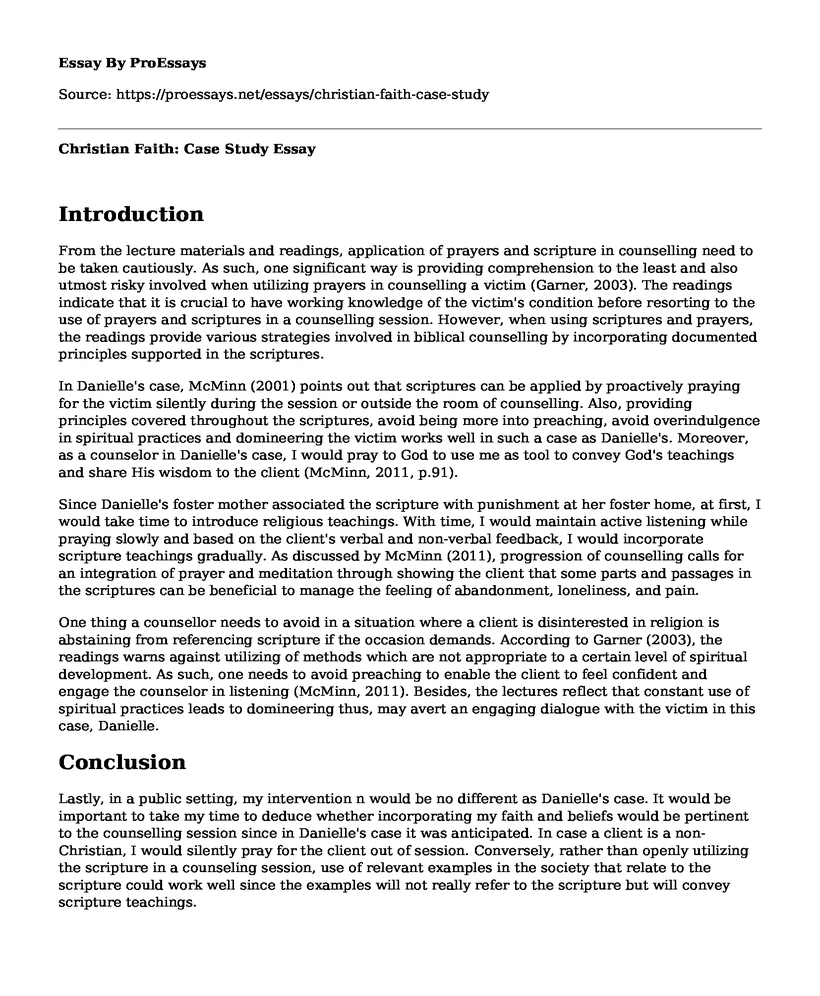Introduction
From the lecture materials and readings, application of prayers and scripture in counselling need to be taken cautiously. As such, one significant way is providing comprehension to the least and also utmost risky involved when utilizing prayers in counselling a victim (Garner, 2003). The readings indicate that it is crucial to have working knowledge of the victim's condition before resorting to the use of prayers and scriptures in a counselling session. However, when using scriptures and prayers, the readings provide various strategies involved in biblical counselling by incorporating documented principles supported in the scriptures.
In Danielle's case, McMinn (2001) points out that scriptures can be applied by proactively praying for the victim silently during the session or outside the room of counselling. Also, providing principles covered throughout the scriptures, avoid being more into preaching, avoid overindulgence in spiritual practices and domineering the victim works well in such a case as Danielle's. Moreover, as a counselor in Danielle's case, I would pray to God to use me as tool to convey God's teachings and share His wisdom to the client (McMinn, 2011, p.91).
Since Danielle's foster mother associated the scripture with punishment at her foster home, at first, I would take time to introduce religious teachings. With time, I would maintain active listening while praying slowly and based on the client's verbal and non-verbal feedback, I would incorporate scripture teachings gradually. As discussed by McMinn (2011), progression of counselling calls for an integration of prayer and meditation through showing the client that some parts and passages in the scriptures can be beneficial to manage the feeling of abandonment, loneliness, and pain.
One thing a counsellor needs to avoid in a situation where a client is disinterested in religion is abstaining from referencing scripture if the occasion demands. According to Garner (2003), the readings warns against utilizing of methods which are not appropriate to a certain level of spiritual development. As such, one needs to avoid preaching to enable the client to feel confident and engage the counselor in listening (McMinn, 2011). Besides, the lectures reflect that constant use of spiritual practices leads to domineering thus, may avert an engaging dialogue with the victim in this case, Danielle.
Conclusion
Lastly, in a public setting, my intervention n would be no different as Danielle's case. It would be important to take my time to deduce whether incorporating my faith and beliefs would be pertinent to the counselling session since in Danielle's case it was anticipated. In case a client is a non-Christian, I would silently pray for the client out of session. Conversely, rather than openly utilizing the scripture in a counseling session, use of relevant examples in the society that relate to the scripture could work well since the examples will not really refer to the scripture but will convey scripture teachings.
References
Garner, G. O. (2003). The Christian Faith and its Relevance to Counselling-Attempts at" Integration".
McMinn, M.R., (2011). Psychology, theology, and Spirituality in Christian Counselling. Tyndale House Publishers. Accessed from https://read.amazon.com/?asin=B007MALC8U
Cite this page
Christian Faith: Case Study. (2022, Jun 19). Retrieved from https://proessays.net/essays/christian-faith-case-study
If you are the original author of this essay and no longer wish to have it published on the ProEssays website, please click below to request its removal:
- Paper Example on Soteriology
- Social Determinants of Health, Poverty and Christian Views Essay
- The James Museum of Western Wildlife Art Essay
- The Indian Religious Culture Essay Example
- Modernity: Integrating New Metaphysics, Theology Into Christianity - Essay Sample
- 3 Wisdom Subjects I Learned From Class Attendance - Essay Sample
- Essay Example on God is Generous: He Offers Seed for Harvesting Lives







